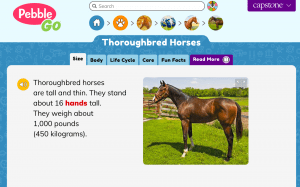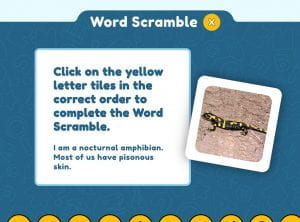Review 3: Interactive Book from PebbleGo
Title: Thoroughbred Horses
Capstone. (2020a). Thoroughbred Horses. PebbleGo. https://site.pebblego.com/modules/1/categories/34/articles/239

For the purpose of this review, an interactive text was chosen from the website PebbleGo. PebbleGo is a database of nonfiction digital texts for children in grades K-3. This interactive book was chosen to evaluate for the digital features of the text and its digital affordances. This text can be categorized as a “digital narrative” (Walsh, 2013, p. 186), as it was produced using software. It also falls under Lamb’s (2011) categorization of a “reference database” which “provides nonlinear and organized access to records of information through search tools, indexes of subjects” (p. 14).
To access the PebbleGo database schools must have a paid subscription. These packages vary from $1299 for a “Bronze” subscription up to “Platinum” for the price of $2399 (Capstone, 2020b). Schools must account for this in their budgets and, depending on the context, this may not be affordable and therefore accessible. If schools do sign up for PebbleGo, families can access the databases at home using their school log in accounts.
As this review focuses on a non-fiction text, we must first acknowledge the differences afforded by the non-fiction genre in comparison with fiction. Any quality non-fiction book has textual features such as a table of contents, glossary, index, captions and highlighted or bold keywords (Capstone, 2020c). In terms of non-fiction illustrations some key differences are that photographs, charts, graphs and other informational graphics are used (Capstone, 2020c).
This interactive text has a nonlinear progression (Lamb, 2011; Walsh, 2013) as the reader can choose from different subheading topics for the text that include; size, body, life cycle, care and fun facts. There is also a ‘read more’ option that links the reader to different literature options that fall under the same genre and are related; such as Palamino Horses. There is also access to video of a horse running and audio of a horse neighing. These aspects lead to this becoming classified as a form of transmedia storytelling (Lamb, 2011).
The text has a ‘read to me’ feature which highlights the word as it reads, and the user simply clicks on the speaker icon to have the passage of text read aloud. Keywords are bold and red font, these are also clickable and take the viewer to a glossary definition. The word and definition can also be read aloud by clicking the button. These added affordances of the technology can promote positive outcomes for improving background knowledge following Biancarosa and Griffiths (2012) who state; digital text with dictionaries or activities can lead to progresses in phonological awareness, reading skills, and vocabulary knowledge for young learners.
An issue found with this text is that it provides somewhat unrelated photographs of horses on each page, for example; the photograph represented on the page under ‘Body’ has a jockey riding a horse at a distance. If the reader directed themselves to this page to learn more about a horse’s body and its characteristics, why would this page not include a diagram with labels? Duke et al. (2013) highlights the importance that graphics play in quality texts so it could be deduced that this texts graphics are of a poor quality.
This interactive form is highly participatory as it relies on the reader’s gestural manipulation to navigate through, this is also a form of constructing meaning from the text (Bourchardon & Heckman, 2012). The gestural manipulation is easy and user friendly enough for lower primary aged students, which is the target audience as listed by PebbleGo.
There is a games feature embedded in the text, but the content is unrelated to the chosen text. For example; while reading the Thoroughbred Horses text the games feature links you to a jigsaw puzzle of a monkey. Also, some of the games are quite broad and could be too difficult depending on the individual learner of a lower primary age. These games included higher level vocabulary, this could become frustrating for early readers and EAL students. The games section does not have the support feature of the ‘read aloud’. It could be that the games feature on this site is to check a box and be a filler. A spelling mistake was also found on the Word scramble game so while this may be appealing to children it does not have much to do with the text (Yokota & Teale, 2014).

This text could be used for student-centred research projects. It can align with the English curriculum “interpreting, analysing and evaluating of literacy” where students “use comprehension strategies to build literal and inferred meaning and begin to analyse texts by drawing on growing knowledge of context, language and visual features and print and multimodal text structures” (Australian Curriculum Assessment and Reporting Authority, n.d.-b). Common Core State Standards Initiative (2020) also acknowledges the importance for learners to have wide-ranging opportunities to build knowledge through informational texts so they can learn autonomously. However, teachers should be aware of the games feature and decide whether or not this can add to learner’s experience of this interactive text.
References
Australian Curriculum Assessment and Reporting Authority. (n.d.-b). English. https://www.australiancurriculum.edu.au/f-10-curriculum/english/
Biancarosa, G., & Griffiths, G. G. (2012). Technology tools to support reading in the digital age. The Future of Children. 22(2). 139-160. https://muse-jhu-edu.ezproxy.csu.edu.au/article/508199
Bourchardon, S., & Heckman, D. (2012). Digital manipulability and digital literature. Electronic Book Review. http://www.electronicbookreview.com/thread/electropoetics/heuristic
Capstone. (2020a). Thoroughbred Horses. PebbleGo. https://site.pebblego.com/modules/1/categories/34/articles/239
Capstone. (2020b). PebbleGo by Capstone: Pricing. https://pebblego.com/pricing
Capstone. (2020c). Text feature definitions and examples. Capstone: Curriculum Resources that Inspire Today’s Learners. https://www.capstonepub.com/classroom/sites/PDFs/teaching-text-features/Chapter_1/Table_1-2_Text_Feature_Definitions_and_Examples.pdf
Common Core State Standards Initiative. (2020). Key shifts in English Language Arts. http://www.corestandards.org/other-resources/key-shifts-in-english-language-arts/
Duke, N., Norman, R., Roberts, K., Martin, N., Knight, J., Morsink, P., & Calkins, S. (2013). Beyond Concepts of Print: Development of Concepts of Graphics in Text, PreK to Grade 3. Research in the Teaching of English, 48(2), 175-203. www.jstor.org/stable/24398654
Lamb, A. (2011). Reading redefined for a transmedia universe. Learning and leading with technology, 39(3), 12-17. http://ezproxy.csu.edu.au/login?url=http://search.ebscohost.com/ login.aspx?direct=true&db=ehh&AN=67371172&site=ehost-live
Walsh, M. (2013). Literature in a digital environment. In L. McDonald (Ed.), A literature companion for teachers. (pp. 181-194). Primary English Teaching Association Australia (PETAA). https://doms.csu.edu.au/csu/file/863c5c8d-9f3f-439f-a7e3-2c2c67ddbfa8/1/ALiteratureCompanionforTeachers.pdf
Yokota, J., & Teale, W. H. (2014). Picture books and the digital world: Educators making informed choices. The Reading Teacher, 67(8), 577-585. http://doi:10.1002/trtr.1262
